Fantasia in paint: How Paula Rego made Disney dance
18 October 2016
Hailed as one of Britain's greatest living artists, the work of Paula Rego has been without a major retrospective for two decades. A new exhibition of her paintings inspired by Disney's animated masterpiece, Fantasia, goes some way to rectifying this. WILLIAM COOK talks to Rego about a childhood formed in Portugal and the power of fantasy and storytelling. “If you don’t know what to draw,” she says, “read a story.”
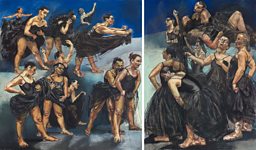
Paula Rego is one of Britain’s greatest living painters, but she hasn’t had a major retrospective in Britain for 20 years. Now aged 81, a comprehensive survey of her work is long overdue, but in the meantime one of London’s leading commercial galleries is staging the next best thing.
Dancing Ostriches at Marlborough Fine Art is a compact exhibition of some of the most arresting images of Rego’s career: nine big ballerina paintings, inspired by Disney’s Fantasia. Like all of Rego’s finest works, they’re both theatrical and intimate. This is a rare opportunity to see them all together, in one room.
Rego’s intense artistry is very different from Walt Disney’s feelgood movies, but they’re both brilliant storytellers
‘I had such fun doing them,’ reveals Rego, in our email interview. ‘Buying the costumes in particular, as we knew nothing about ballet.’
Her memories of Fantasia stem from her childhood in Portugal. ‘I adored Disney. I went with my grandmother to the cinema whenever they were on. I liked Snow White too, and Dumbo. Fantasia was full of different stories. Watching Bambi, everybody cried, even the grownups.’
Rego’s intense artistry is very different from Walt Disney’s feelgood movies, but they’re both brilliant storytellers who transport you into another world. Like Disney cartoons, some of her most powerful artworks have been inspired by folklore - fairy tales and nursery rhymes.
‘I started doing nursery rhymes for my granddaughter Carmen. I did a little book for her. It was very easy. You read a story at night and in the morning you have an image.’
Other people’s stories have always been a rich source of inspiration. It was her late, lamented husband, the artist Victor Willing, who gave her the idea for this way of working.
‘When I got stuck, he said, “If you don’t know what to draw, read a story.” I’ve used his advice ever since.’
This approach has provided the impetus for some of her most evocative pictures, including her Children’s Crusade series, which is included in this exhibition. ‘It gives you a story as a start and you can turn it into your own.’
Paula Rego was born in Lisbon in 1935. Her father was an electrical engineer. When she was a toddler, her father was posted to Britain and took her mother with him, leaving Paula, an only child, in Portugal with her grandmother.
She ended up at the Slade, one of Britain’s most prestigious art schools
She went to an English speaking school in Portugal. In 1951, she came to London. It was a world away from her childhood home.
‘Britain still had rationing when I arrived,’ she recalls. ‘You could only buy olive oil at the chemist in little bottles. There was yellow fog and no wine – just beer or cider.’
Paula had been sent to Britain to go to finishing school, but she yearned to study art instead. She ended up at the Slade School of Fine Art, one of Britain’s most prestigious art schools.
‘I loved my tutor, William Townsend,’ she remembers, ‘but I didn’t get on with the style of teaching – it was too stiff.’
The greatest reward was meeting Victor Willing, a fellow student. After they finished their studies, they moved to Portugal. They had three children together.
From the mid Fifties to the mid Seventies, Paula and Victor divided their time between Britain and Portugal. When Paula’s father died, Victor reluctantly took on his electrical business in Portugal. ‘I would have rather stayed in England,’ reflects Paula. ‘It was bad for both of us.’
In 1974, they returned to London, where Victor resumed his true vocation as an artist. He died in 1988, aged just 60, after a long struggle with multiple sclerosis. ‘I miss him. He was so intelligent and I loved him so much.’
It was only in her fifties, after her husband’s death, that Rego’s work started to sell for significant prices. ‘It’s never fruitful not having money or being able to sell your work – it’s dreadful,’ she declares. Yet although it was clearly not much fun for her, there are some consolations to late recognition.
Unencumbered by celebrity, she had time to find her own style, her own voice
Early fame and fortune can stunt an artist’s development. Rego was already in her forties before she was granted her first big solo show.
Unencumbered by celebrity, she had time to find her own style, her own voice.
Despite his untimely death, Victor’s influence endured, in paintings like The Dance, now in the Tate.
‘I started planning it before Vic died, but it took me a long time to finish it afterwards. I did lots of drawings for it which he saw. They were all of women dancing but he suggested I put in some men. He said it didn’t make any sense without them.’
Willing was right. This addition turned a fine painting into a masterpiece.
After all these years, her Portuguese roots still run deep. ‘Portugal is where I came from. That’s very important. The sea, the donuts on the beach, the pine trees. I miss my house in Ericeira the most.’
And yet, like so many emigres, it is her separation from her ancestral home which enables her to transform it into art. ‘I love London. I’m more able to draw life in Portugal in my studio here than when I’m there. The two work together.’

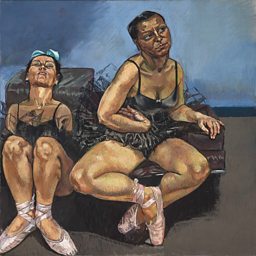


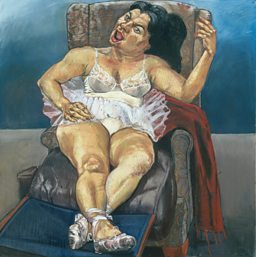
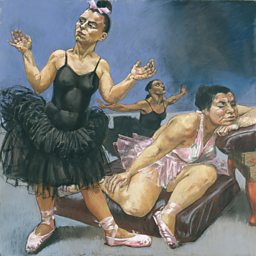
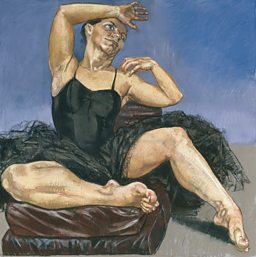
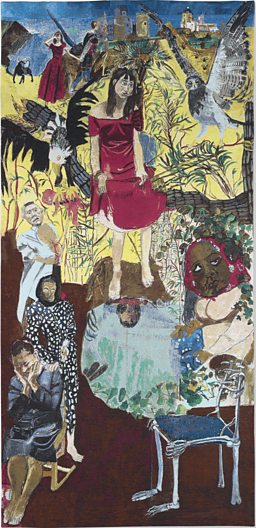

The nations paintings online
More British art from the archives
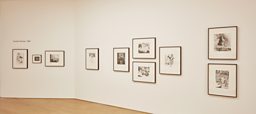
Paula Rego: Dancing Ostriches is on exhibition at The Marlborough Art Gallery, London from 28 September to 12 November 2016.
More from BBC Arts
-
![]()
Picasso’s ex-factor
Who are the six women who shaped his life and work?
-
![]()
Quiz: Picasso or pixel?
Can you separate the AI fakes from genuine paintings by Pablo Picasso?
-
![]()
Frida: Fiery, fierce and passionate
The extraordinary life of Mexican artist Frida Kahlo, in her own words
-
![]()
Proms 2023: The best bits
From Yuja Wang to Northern Soul, handpicked stand-out moments from this year's Proms







